 loading
loading
featuresRace, speech, and valuesWhat really happened at Yale. Kathrin Day Lassila ’81 is the editor of the Yale Alumni Magazine. Alice Baumgartner ’10, ’19PhD, and Mark Alden Branch ’86 contributed reporting. 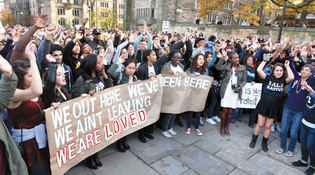 Arnold GoldYale students cheered at the “March for Resilience” of November 9. The march ended with music and dancing. View full imageFirst of all, it was nothing like the sixties. During the heated debates at Yale over race and free speech in November, the surge of media and social media coverage conveyed the impression of a student body out of control. In reality, the campus was quiet. There were no sit-ins. No buildings were occupied. Day after day, you could stroll through Cross Campus and see only the usual random assortment of students walking to class, lost in thought or texting on their phones. In all of November there were only three large outdoor gatherings, and one of them turned into a massive dance party. What did take place was an intellectual and emotional upheaval. Inside dorm suites, dining rooms, the four cultural centers, and in lecture and seminar rooms, students and faculty of all colors were having intense, sometimes painful conversations about profound subjects: race, free speech, their values, Yale’s values. It was a sobering, often divisive period. But it was also, in many ways, a teaching moment. One Atlantic writer called the student unrest “a fight over Halloween costumes.” While many bloggers saluted the activists, others mocked “privileged Yale students” upset by the mere idea of a potentially offensive costume. But that now-famous e-mail from Erika Christakis about Halloween was only a spark. The real reason behind the protests was what Yale president Peter Salovey ’86PhD calls the “accumulated experience” of racial slights over time. In her October 30 e-mail to students in Silliman, Associate Master Erika Christakis criticized an earlier e-mail from the Intercultural Affairs Council, which had suggested that students think carefully about whether their costumes could offend someone. Christakis, a Yale lecturer on child and young adult development, called Halloween “a day of subversion for children and young people” who might want to be “a little bit inappropriate or provocative or, yes, offensive.” (The e-mail is on TheFire.org.) Within hours, Christakis’s message had been widely shared outside of Silliman, and the reaction was sharp. An open letter posted the same night read, “You deem the call for sensitivity ‘censure’—one which you say comes ‘from above,’ not from the students, as if the repeated requests of many students of color do not count.” The other spark was an October 31 Facebook post by a sophomore alleging that a member of the fraternity Sigma Alpha Epsilon had “turned away a group of girls from their party last night, explaining that admittance was on a ‘white girls only’ basis.” She wasn’t present at the event and had heard the story from others, but she wrote that the same thing had happened to her last year at the same fraternity. (The Yale College Dean’s Office investigated and found that while women of color had been at the party, two people said they had heard someone guarding the door say, “White girls only.”) On November 4, 350 people crowded into Yale’s Afro-American Cultural Center to talk about these two events. Those conversations would blossom into student rallies, multiple discussions with the Yale administration, and the midnight demands delivered to Salovey on November 12. Ultimately, the organizing and the anger grew out of the continuing debate over race relations that started in Ferguson, Missouri, in 2014 and has spread across the nation—including to many campuses. A national website called TheDemands.org has collected a list of student demands around the country; as of early December, 72 campuses were represented, including Dartmouth, Brown, and Harvard. At the same time, the Yale students’ motives were intensely personal. They described, to administrators, on social media, and in student publications, the experience of putting up with racial jokes, slurs, and misperceptions. Taylor Eldridge ’16 told the Yale Alumni Magazine that students closed her college gate behind them in her face, as if she were trying to sneak in. Although she was a member of the track team, she stopped wearing her navy blue track sweats because she was tired of being mistaken for a custodian. “Even though I’m here, even though I got the letter,” she says, “I’m still perceived as not really supposed to be here.” In the November issue of the New Journal, Dave Harris ’16 wrote about playing video games with other brand-new freshmen. When Harris won his fifth game in a row, his white opponent shouted, “Ahhhh you nigger.” He quickly apologized, saying, “It’s just because of where I grew up, you understand.” There was “a moment of silence,” Harris writes, “and then a chorus of laughter.” Yale College dean Jonathan Holloway ’95PhD, who is African American, underlines that racial slights are far from unique to Yale. (Several students agreed.) But for people of color, Holloway told an audience of alumni in Battell Chapel on November 20, the privilege of being at Yale does not cancel out such slights. “Everybody here is privileged,” he explained, “but we don’t all have the same experience.” On campus, he’s a faculty member and a dean. But when he steps off campus, “I’m just another black man.” When he drives to the Southeast to visit family, he sets the cruise control to the speed limit plus three miles per hour: as an African American, he says, he can’t run the risk of being stopped. 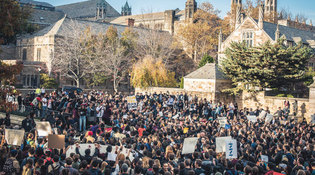 Philipp ArndtMore than a thousand people participated in the March for Resilience. View full image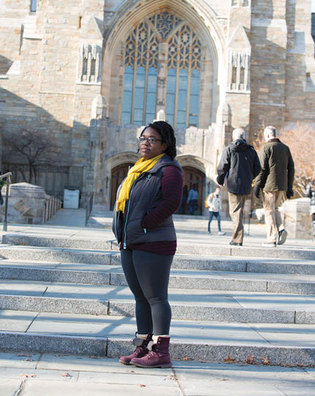 Mark OstowTaylor Eldridge ’16, above right, has found that students close the gates to their colleges in her face. View full imageSome of the media coverage caricatured the protesters; the Wall Street Journal editorial page called them “Yale’s little Robespierres.” On the other side, Christakis’s searching e-mail was sometimes misrepresented as a full-throated defense of blackface. And on at least four occasions, the behavior on campus was in fact extreme. The example that went viral was the student captured on video screaming at Silliman College master Nicholas Christakis ’84. But there were others. Christakis himself got into a shouting match with students. Grant Mueller ’17, president of Sigma Alpha Epsilon, says that some African American SAE members had been called Uncle Toms, and that someone, possibly a student, had spat at his feet. Finally, after a speaker at a free-speech conference joked that the reaction to Christakis’s e-mail seemed as if someone had “wiped out an entire Indian village,” a group of students arrived to protest outside; most of the protesters were orderly, but at least two students who attended the conference were spat on as they left. Those acts were exceptions, however. Most students who participated in the debates did so passionately but reasonably. And the range of emotion and opinion was wide. On November 5, Holloway met with 200 students who had gathered on the plaza in front of Sterling Library—not to protest, but to chalk messages of support for people of color. When they told him about their experiences of racism at Yale, many were confrontational, but many were crying. The single largest event of the entire period was the “March for Resilience” on November 9—again, not a protest, but this time a celebration. Marchers chanted, “We out here / We’ve been here / We ain’t leaving / We are loved.” More than a thousand people participated, many joining along the way, and the rally ended with music and dancing on Cross Campus. The entire event was organized without the knowledge of Yale administrators, who weren’t sure what to expect when they found out late the night of November 8 that a rally was planned. It turned out to be, says Holloway, “a thing of beauty.” Hundreds of graduate and professional students attended forums held across campus, says Kim Goff-Crews ’83, ’86JD, Yale’s secretary and the vice president for student life. The Graduate School convened one that was attended by 300 to 400 students, and others took place at the nursing, medical, divinity, and other schools. Generally, says Goff-Crews, graduate and professional students “are focused on issues about faculty mentorship and diversity, and relevant and respectful learning experiences in both the curriculum and the classroom environment.” The most prominent group that emerged from the discussions around campus was Next Yale, a loose coalition of at least 200 students, mostly undergraduates and mostly women of color. At midnight on November 12, they marched to the president’s house, met him and his wife on the sidewalk, and delivered a series of demands. These included, among others: removal of the Christakises as master and associate master, increased funding for the cultural centers, an ethnic studies distributional requirement for all undergraduates, mental health counseling at the cultural centers, and more resources for low-income students. They also asked for symbolic changes, including a campus monument commemorating the local Native Americans, the renaming of Calhoun College, and elimination of the college title “master.” Next Yale had vocal support on campus and from several alumni groups, but again, opinions ranged widely. Student columns in the Yale Daily News argued all sides, from “The diversity behemoth is an enormous waste of academic time and energy” (Isaac Cohen ’16) to “White ignorance reproduces racist norms” (Cassandra Darrow ’18). So did alumni commentators (as the Letters section in this issue reflects). Some students were reluctant to express disagreement for fear of undercutting the activists; one residential college master was approached in confidence by a group of black students who said their feelings were more moderate than Next Yale’s. Andi Peng ’18, born in China but raised in rural Ohio, took issue with the disrespect she saw on both sides at the height of the debates. Students and administrators alike shouted each other down. And as an Asian American, Peng felt excluded from a student movement of mostly African Americans. Michael Robinson ’15, ’18MBA, also differed with the activists. He wrote in the Washington Post, “I cannot and will not dismiss the way others may feel, or characterize their experience at Yale as inaccurate,” but “the Yale I know helped me embrace and love my blackness in an anti-black world.” Austin Muñoz ’16, a senior from South Bend, Indiana, who is Puerto Rican, adds by e-mail: “I don’t doubt that students have experienced racism on campus. But I think it’s misleading to suggest that every minority student has felt victimized by malicious racial stereotyping during their time here. I will remember Yale as a welcoming place where I made amazing friends.” 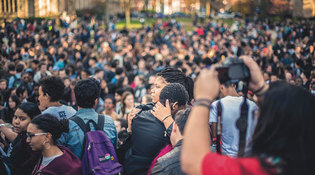 Philipp ArndtAt the March for Resilience. View full image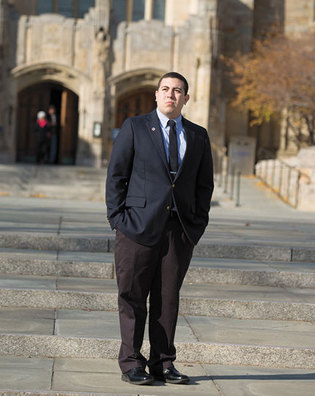 Mark OstowGabriel Ozuna ’16 was troubled by the decision of two liberal student parties to boycott a Yale Political Union debate on affirmative action. View full image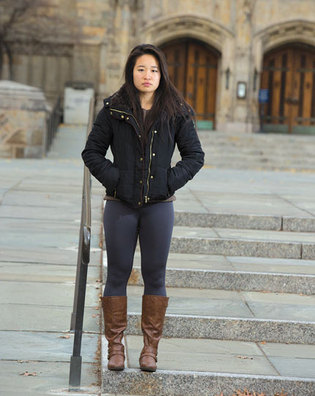 Mark OstowAndi Peng ’18 took issue with the disrespect she saw on both sides at the height of the debates. View full imageHenry “Sam” Chauncey ’57 was the secretary of the university during the Yale debates of the Sixties and Seventies over race and free speech. On the campus today, he says, “There really is a complex problem that has arisen over the two issues of free speech and civility. At times the expression of free speech can become uncivil. And so the question is, if a free expression offends a person should the free expression be in any way curtailed?” This central question was discussed all over Yale during November, and by many outside Yale who criticized the student protests as an attack on free speech. One episode that raised concerns for some students took place at the Yale Political Union: two parties on the left boycotted a debate over a resolution to “end affirmative action.” The boycott troubled Gabe Ozuna ’16, a third-generation Mexican American and member of the Federalist Party. He says students of color do face “incidents of ignorance” on campus—but he feels that debate and discussion are the solution, not the problem. He also worries that the left’s boycott reflects a larger reluctance to engage in ideas. “It offends me,” he paraphrases, “therefore, I’m right, you’re wrong, because I don’t feel safe.” Cole Aronson ’18, a Yale Daily News columnist, adds, “You are not at Yale to feel—in the thick sense of it that’s being used now—safe. I think that you’re at Yale to feel unsafe intellectually.” To some extent, the two sides are talking past each other. “There’s a debate, but the debates are not aligned,” says Holloway. He has spent hours listening to the student activists, and he believes they “understand that at the university they’re going to be challenged, and that sometimes it won’t be comfortable.” The “safe space” they’re asking for, he says, is not a constriction of discussion but a change in social and cultural mores—for instance, in the culture of their residential colleges, so that they’re no longer shut out if they forget their IDs. (In Time, Annie Murphy Paul ’95 wrote that the protests were “about a sense of belonging.”) One activist, Rose Bear Don’t Walk ’16, told the Yale Daily News, “Our movement is founded in the idea that all people’s voices should be heard. We cannot maintain the integrity of this message whilst questioning or silencing other accounts.” Stiles master Stephen Pitti ’91, who has been at Yale as a professor since the late nineties, says, “We’re now seeing students engaged in dialogue and debate. I’ve been very impressed with the way students and others articulate their diverse perspectives. I see it every day in the dining hall, and I hear about students having these discussions in their suites.” In practice, “free and open speech” on campus is “embraced more than ever.” By far the most difficult campus debate on free speech was over Erika Christakis’s e-mail and Next Yale’s call for the Christakises’ dismissal from Silliman. By mid-December more than 80 faculty had signed a letter expressing their concern that the e-mail was “misinterpreted, and in some cases recklessly distorted, as support for racist speech” and used “as justification for demanding the resignation of our colleagues from their posts at Silliman.” And although the Christakises remain at Yale, in their roles both as faculty and at Silliman, Erika has decided not to teach her usual courses next semester. (Several administrators said that Yale had tried to persuade her to keep teaching.) She told the Washington Post, “I worry that the current climate at Yale is not, in my view, conducive to the civil dialogue and open inquiry required to solve our urgent societal problems.” Nicholas is taking a scheduled sabbatical from teaching in the spring. Yale president Kingman Brewster Jr. ’41, Chauncey recalls, once said: “Universities should be safe havens where ruthless examination of realities will not be distorted by the aim to please or inhibited by the risk of displeasure.” But Brewster also said, “Never let disagreement fester into disrespect.” Is it possible to have free speech and “safe space”? Salovey says, “We can do both. We can allow Yale to be a place where anyone can give voice to any idea. But it can also be a community characterized by the kind of respect that allows one to seriously contemplate an unpopular idea, even an idea that one finds offensive.” (See interview.) He adds: “That may sound idealistic, but I think Yale should always be pursuing that ideal.” Beginning with his first communications to the campus about the student unrest, Salovey consistently stressed two points: that “Yale must be a place where each person is valued automatically, without having to demand or labor for that recognition”; and that Yale has “a commitment to free expression and an open exchange of ideas free from intimidation.” In the end, he announced a substantial plan to support diversity and education about diversity. (See “Future Plans” box at left.) After it came out, US Secretary of Education Arne Duncan called Salovey to commend the plan and Yale’s willingness to engage with students. Salovey and Holloway also wrote to the Silliman community to reaffirm the Christakises’ place in Silliman College. On both sides, some found fault. Supporters of the Christakises asked why the administration had waited more than two weeks to weigh in on the e-mail controversy. Salovey says Nicholas attended a weeklong conference soon after Erika sent her e-mail, and that when the Christakises came back he wanted to get a clear picture of the interactions between Nicholas and the students before making an announcement. He adds, “No one was going to be pushed out of his or her position because of an opinion stated in an e-mail message.” As for the activists, Next Yale members said at a teach-in on November 18 that Salovey’s announcement did not come close to addressing all their demands. “Keep fighting!” someone yelled from the audience. The student activists said that they would. Soon after that, the campus was caught up in its year-end preoccupations—exams, final projects, holiday plans. Students buried themselves in the libraries. The administration began moving to put Salovey’s plan in motion, and the media and social media were turning their focus elsewhere. For the moment, Yale was tranquil.
|
|
7 comments
-

jan jansen, 2:42pm January 18 2016 |  Flag as inappropriate
Flag as inappropriate
-

diogenes, 8:23pm January 18 2016 |  Flag as inappropriate
Flag as inappropriate
-

Jared Taylor, 2:00pm February 01 2016 |  Flag as inappropriate
Flag as inappropriate
-

Jared Taylor, 3:13pm February 05 2016 |  Flag as inappropriate
Flag as inappropriate
-

Joseph Brennan, 7:31pm February 06 2016 |  Flag as inappropriate
Flag as inappropriate
-

Anonymous '71, 12:25pm February 26 2016 |  Flag as inappropriate
Flag as inappropriate
-

Brittany Kelly, 11:46pm March 07 2016 |  Flag as inappropriate
Flag as inappropriate
The comment period has expired.So all this fuss for one racist incident at a student party and a deliberately misinterpreted/misquoted email? Wait I forgot: there was also a lot of talk about feelings.
I bet the implication that most "priviledged" students are inherently racist and bigoted was thrown around thousands of times during all these marches. On a campus where perhaps 90% voted for Obama. Get a perspective. Or at least come with concrete racist incidents worth mentioning or clearly institutionalized racism. Then I might even join your protest.
Master Pitti of Stiles is quoted as In practice, “free and open speech” on campus is “embraced more than ever.”
Really, I seriously doubt it Pitti. More like PC speech is embraced more than ever.
Just as I suspected: a frenzy of hysteria over nothing leads to craven capitulation. Am I the only alumnus who thinks that if Yale has $50 million to spend on "increasing diversity," it sure doesn't need another dime from me?
For a careful analysis of this capitulation by Jared Taylor, class of 1973, see this link.
http://www.amren.com/features/2016/02/yale-capitulates/
Why anyone would give money to this school to waste on their diversity crusade
is nuts
We had no quarrel with Yale, just trifles like the War, but we didn't do Halloween.
This used to be my dream school. Now what am I supposed to do? If I get in, will I still be allowed to attend if I disagree with the activists, or will they "demand" that I leave too?